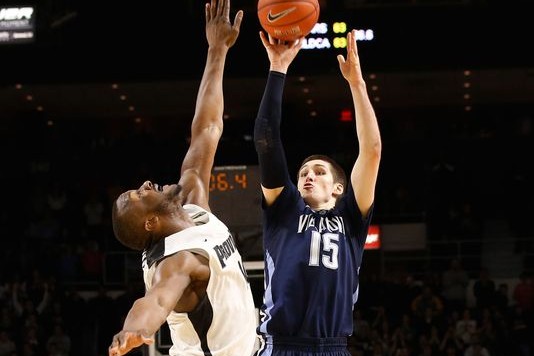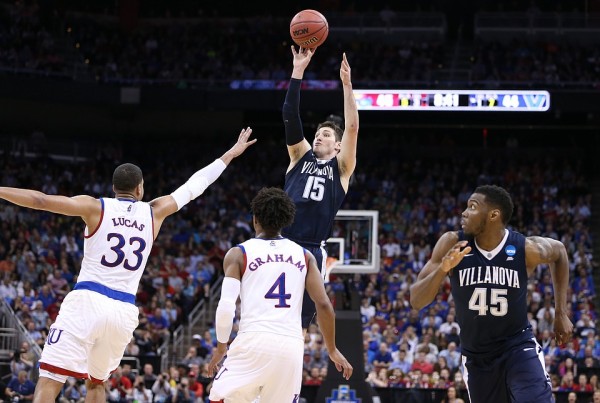The Villanova Wildcats and the Oklahoma Sooners both arrive at the championship-making stage of the 2015-2016 college basketball season at a point in basketball history when the Golden State Warriors and the Splash Brothers are redefining the pro game.
Jump shooting — 3-point jump shooting, to be precise — is in.
How’s it GOINK, Phil Jackson? Basketball is GOINK the way of the 3-point shot. That’s what the cool kids do these days.
Villanova and Oklahoma — twin two seeds both led by coaches in their second Final Fours, one of which will coach in his first title game Monday night — are not hesitant about shooting the three-ball. Jay Wright wants his players to think aggressively on the court and then settle into a comfortable rhythm. Lon Kruger has made a point of saying to assembled journalists this week that his coaching philosophy has evolved in the direction of making sure players have fun within his larger system. Shooting threes — not putting too many restrictions on his players, trusting them to take good shots — is very much part of that.
So, as the Wildcats and the Sooners prepare for Saturday’s first national semifinal — which is the better of the two games, but goes first because ratings king North Carolina hasn’t played in a first-game semifinal since 1993 — they shouldn’t abandon the three-pointer. These schools — who met in the Elite Eight on the same weekend Lon Kruger coached in his first Elite Eight at Kansas State back in 1988 — shouldn’t feel bashful about launching shots.
As always, it’s not necessarily about taking threes or not; the eternally relevant question is, “Is each shot a good shot?”
Good shot-bad shot is always an essential element of basketball success. Several dozens of shots are taken each game, often more than 100. Teams can survive a handful of them, but it’s hard enough to hit an open three with regularity. Bad shots — contested, off balance, off a dribble instead of a catch (for most players), taken in ignorance of an open man for an easy layup or dunk, etc. — can’t accumulate to a high level, unless one’s offensive rebounding prowess (or defensive acumen at the other end) is substantial enough to override that deficiency.
Buddy Hield made 8 threes today. That's a lot. #MarchMadness https://t.co/l021v91hCI
— NCAA March Madness (@MarchMadnessMBB) March 27, 2016
In the Elite Eight, the two foremost shooters for Villanova and Oklahoma — Ryan Arcidiacono and Buddy Hield — lived on the right side of the good shot-bad shot equation, despite playing very different kinds of games within 40-minute mosaics which acquired sharply contrasting tones and textures.
Above, you can see that Buddy Hield won in a splashy way — eight 3-point splashes, to be precise, in 13 attempts. Yes, a few of those threes were bad shots, but for the most part, Hield took threes that weren’t too far behind the arc. Just as important is that Hield shot most of those threes off catches and was fully squared up to the basket when he made the catch. Oregon gave him space, and Hield was entirely correct to shoot when given that space. He scored 37 points, but those were largely “smart” points, too. Hield built his monster scoring game on the solid foundation of good shots.
Villanova-Kansas was a defense-dominated street fight. Within that game, the temptation to get a quick three from a long hoist was considerable.
Arcidiacono didn’t take the bait.
Instead of quick-trigger jacks from 25 feet, Arcidiacono didn’t take many shots — only six for the game, three from three-point land. He focused on his defense and committed only one turnover in 33 minutes of high-intensity basketball. He ran his team and led not so much by making spectacular plays, but by avoiding mistakes. Kansas made more of them, and that was Villanova’s path to victory.
As we turn to Saturday, then, one of the obvious talking points will be the big-dome shooting backdrop in Houston. Last year, NRG Stadium hosted the South Regional, with UCLA, Gonzaga, Utah, and Duke competing for a Final Four spot. Those three games produced a 3-point shooting line of 23-for-86, or 26.7 percent.
Yes, Arcidiacono and Hield are great shooters. Arcidiacono is not to be underestimated in a tale-of-the-tape matchup against BuddyBall. The “arch-diaconate” has thrived during Lent and Holy Week, missing a total of just 13 shots (12 field goals, one free throw) in four NCAA tournament wins. Arcidiacono has shot over 50 percent on threes during the tournament (11 of 19), and he’s hit at least 50 percent of field goal attempts in all four of his tournament games in 2016. This partly flows from lower shot volume, but nevertheless, he has been more consistent than Hield.
What Hield brings to the party for OU is his ability to go off and dominate games when his shot is on. A 29-point second half against VCU, combined with his 37-point masterwork against Oregon, carried his team when it needed his solo brilliance. In round one against Bakersfield and the Sweet 16 against Texas A&M, Jordan Woodard and other teammates were able to pick up more of the slack. Oklahoma has — in that way — used a balanced approach to get to Houston: two big games from Hield, two big games from the supporting cast, one apiece on each of the first two weekends of the tournament.
As we arrive at the third weekend, VU and OU would love to see Arch and Buddy light it up in Houston. However, with the shooting backdrop being more of an uncertainty in a first game of said weekend (Monday night should be less of a problem), and with both teams being highly competent on defense, Plan A — make it rain all game long — has to be scrapped if the flow of the game suggests as much.
If the first three or four triples are off the mark, and no shooting rhythm exists — or if both defenses are able to take away the three — Nova and OU must be prepared to adjust. Villanova has Daniel Ochefu’s beefed-up low-post offense to turn to. The senior — like a good boxer — can score points with his right hand or his left. That’s an advantage the Wildcats need to use on Saturday.
For OU, Hield would be wise to get to the foul line with paint attacks. A few foul shots early in the game would be a great way to achieve a fundamental in-game goal for good shooters: See the ball go through the basket. As soon as a shooter can feel that feeling — and visualize the ball splashing in his present-tense shooting environment — he can loosen up on his shot. Hield did a very good job against Oregon of not relying exclusively on the three. He shot some 16-footers and occasionally drove the ball, so that the defense couldn’t focus solely on taking away his jumper. Hield will similarly need to mix up his approach against Villanova.
What Oklahoma will also need is some production — not big numbers, but noticeable ones — from Ryan Spangler and Khadeem Lattin. Spangler deferred to his teammates against Oregon, because they were hot shooters. Saturday, Spangler might need to be a little more proactive on offense — not hunting shots, but taking that five-foot half-hook if it’s there in the low post, or a 14-foot elbow jumper if that’s what Villanova gives to the Sooners in the first half. If Spangler takes and makes a shot, instead of all too visibly passing it up, Villanova can play 5-on-4 defense and squeeze Oklahoma.
Lattin played only 13 minutes against Villanova in the regular season meeting between these teams back in December. Simply as a result of his minimal minutes, Lattin is more of a mystery to Villanova than other Oklahoma players. Crashing the offensive glass and being able to dunk the ball in traffic will probably be needed at some point in this game.
*
Villanova and Oklahoma love to shoot the three. Shooters are supposed to shoot, and teams which embrace a given identity should not run away from that identity at the Final Four. That point having been made, though, the Wildcats and Sooners must account for the shooting backdrop and the level of defense that’s likely to come their way.
Start with Plan A, by all means… but have Plan B ready in our latest episode of Good Shot-Bad Shot, the likely point of differentiation in Saturday’s heavyweight semifinal, relegated to the undercard time slot by North Carolina.


